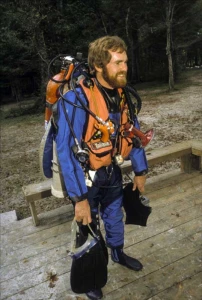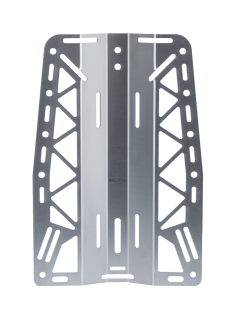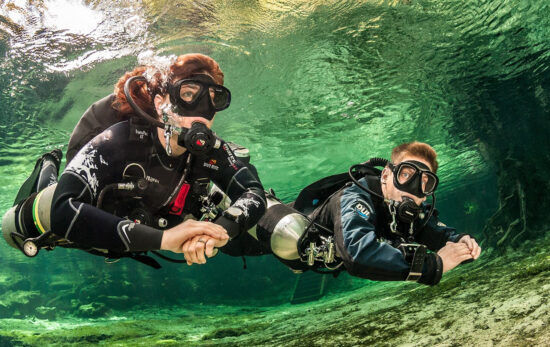When it comes to equipment design, have you ever wondered how certain key measurements came into existence? An interesting example is the measurement between the two holes on a backplate.
Lamar Hires of Dive Rite takes up the story:

“You never forget your first kiss, car or set of diving equipment. When I was diving Rock Bluff in 1981, I wasn’t in the mindset to figure out the gear, I just dived what I had. My first scuba set was a Cressi jacket style BC with a Dacor Pacer 300 regulator. There was no octopus back then. Having a second regulator was still being debated in the open water community. Instruction in the use of an alternate air source was not mandatory in all PADI courses until September 1986. The Dacor Pacer 300 became my second reg when I started cave diving, and I purchased a Sherwood Magnum to serve as my primary regulator. This would later be upgraded to a Poseidon for deep air dives.
We soon found the kit was not matching the challenges cave exploration was throwing up, and when that happens, cave divers get creative and clever with their hands. Florida’s ideal conditions1 are the epitome of what all cave divers would like to experience, and as a direct result of advantageous conditions, tremendous attention has been paid to the design and evolution of optimum equipment.
At the time I wasn’t to know that an invention by Greg Flanagan two years earlier, in 1979, would have a positive impact on my future diving and my career.
Flanagan was a college student at the University of Florida. After experiencing the unwieldy ‘belly bags’ combined with a jacket-style BCD during his cave training with Sheck Exley, Flanagan developed the first metal backplate from a ‘liberated’ aluminum ‘Stop’ road sign and some webbing off a Navy harness. (Interestingly, the design Flanagan created remains relatively unchanged today.) Greg’s new back-mounted BC worked wonders, and he soon became the envy of his cave classmates. He was asked to create backplates for his fellow students as well as ‘old timers’, such as Sheck Exley, Will Walters, Dale Sweet, Steve Straatsma and Tex Chalkley. However, it was Greg’s cave diving buddy, Bill ‘Hogarth’ Main, through his relentless pursuit of cave diving, who made the back plate and harness a foundational component of what is now called the ‘Hogarthian Rig.’

Today, stainless steel and aluminum backplates have a number of regular features. For instance, they are normally approximately 38 cm / 15 inches high by 25 cm / 10 inches wide. There are a number of slots cut into the backplate to accommodate the webbing harness. You also often find that holes have been drilled down the two vertical edges, enabling the diver to secure accessories to the backplate, while additional slots have been cut on either side of the spine, giving the diver the option to cam band a single cylinder to their backplate. There are also one or more pairs of holes in the main spine channel that are primarily used for attaching twin or double cylinders, and these holes are always 28cm / 11 inches apart. This is the standard measurement accepted and recognized the world over. But have you ever stopped to wonder where this measurement came from? Probably not.
Greg had been making backplates with 20cm / 8 inches between the two bolt holes, so how did it jump to the 28cm / 11 inch standard? I was actually responsible for that, and ironically, it was the result of an off-the-cuff comment. Dive Rite was the first company to commercially manufacturer the backplate in 1984. In fact, it was one of 13 original products we launched that year, but I digress. The measurement came about because I received a phone call from the machine shop making the plates, asking where the bolt holes should be drilled. ‘Just drill into the plate two inches down from the top and two inches up from the bottom,’ I replied. On a 38cm / 15 inch backplate that makes an 28cm / 11 inch gap between both the holes, and thus the world standard of 28cm / 11 inches was born.”
1 The Darkness Beckons by Martyn Farr, published 1991
This article was written by Rosemary E Lunn and originally published on the TecRec blog on March 24, 2016.


